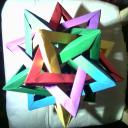
 Here are a few (unfortunately low-quality shots) of a modular origami implementation of five interlocking tetrahedra. This model uses Thomas Hull’s design. The joins are a bit sloppy, but it holds together nicely.
Here are a few (unfortunately low-quality shots) of a modular origami implementation of five interlocking tetrahedra. This model uses Thomas Hull’s design. The joins are a bit sloppy, but it holds together nicely.
Modular origami is quite relaxing, very much like knitting. Once you have mastered a basic pattern, you can just disengange your brain and let your hands do the work. For larger constructions, in fact, it is extremely important to have something else distracting you from what might otherwise become intolerable tedium. Then, after you’ve constructed all your modules, comes the fun part: stitching everything together into the finished shape. This design, in particular, is a bit of a brainteaser; you have to carefully puzzle out where each strut goes, under or over. The final result is satisfyingly impressive.


